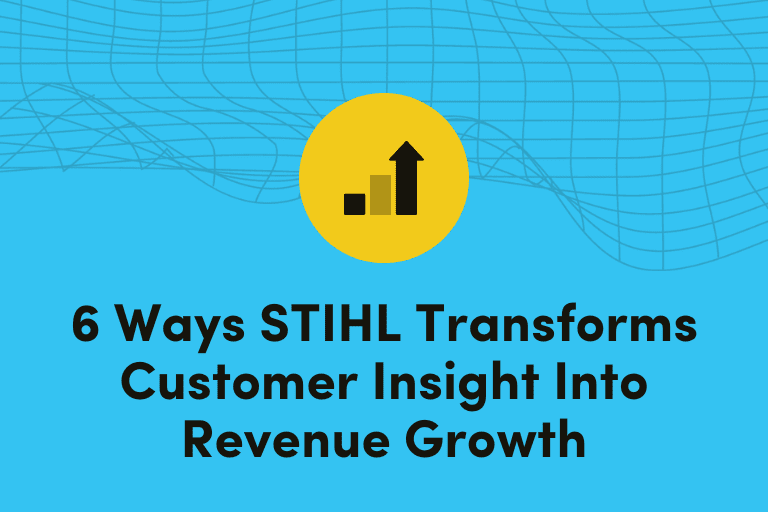In the world of marketing, building an emotional connection with customers (aka. “brand love”) is often the ultimate goal. But this emotional bond doesn’t always translate into a stronger bottom line. For many brands, the challenge is bridging the gap between brand loyalty and measurable business growth. The key to this is understanding your audience on a deep, personal level and using that insight to deliver personalized, relevant communications.
STIHL, a global manufacturer of outdoor power equipment, knows this better than most. The brand has a passionate, loyal customer base—but wanted to translate that affinity into revenue growth. By partnering with adm-Indicia (formerly Indicia Worldwide) and leveraging Iterable’s capabilities, STIHL has successfully bridged that gap.
This article is based on a session from Activate 2025, featuring adm-Indicia and STIHL’s Director of Digital Marketing, Erik Bledsoe. You can watch the full session here.
Overcoming STIHL’s Hyper-Personalization Hurdles
Getting to hyper-personalized, revenue-driving marketing wasn’t instant for STIHL—it started with some clear challenges that had to be addressed head-on:
- Limited Personalization: STIHL needed to talk to their different audiences—homeowners and professionals—in their own language, and their old platform couldn’t weaponize their data for this purpose.
- Data Fragmentation: They had mountains of user data from an over 80% product registration rate, but were unable to utilize multiple data sources for targeting or segmentation.
- Zero Downtime: STIHL required a very tight migration window with zero downtime and a goal of protecting revenue.
The solution was a data-driven approach that combines strategy, data, and technology to create personalized communications that resonate deeply with the audience
6 Ways to Harness Audience Insight for Brand Growth
To achieve this transformation, STIHL focused on six key AI-driven strategies, each powered by deep audience understanding and designed to feel less like marketing, more like a personal conversation.
1. Know Your Audience with Brand Affinity
The Problem: Not all customers are created equal, yet many brands treat them that way. Sending the same offer to every customer fails to recognize the value of your most loyal advocates and can waste resources on those who are less engaged.
The Solution: Use Brand Affinity to score a user’s loyalty based on their interactions, allowing you to identify your most loyal customers. This powerful segmentation enables you to reward your higher-value customers and tailor your approach to others.
Example: We can observe this in action through a fictional STIHL customer, “Andy” –– a high-affinity customer who consistently opens their emails and clicks through. By recognizing this, they knew they could confidently offer him a percentage-off discount, as he had a high propensity to purchase. This strategy has already resulted in double-digit conversion rate increases in initial tests.
2. Trigger Action with Behavioral Targeting
The Problem: Sending generic follow-up emails after a customer browses a product often falls flat. The key is to respond to specific actions in real time, showing that you’re paying attention.
The Solution: Use event-based triggers and a powerful data activation layer to tap into real-time customer signals. This allows you to build multi-touch, automated journeys that respond directly to a customer’s behavior, such as abandoning a cart.
Example: Andy added the MSA 200 battery chainsaw to his cart but never completed the purchase. Instead of doing nothing, a multi-touch abandoned cart journey was triggered. This journey included A/B tests on time delays, subject lines, creative content, and discount codes to determine the most effective combination to prompt him to complete the purchase. STIHL expects this single journey to drive seven figures in incremental revenue next year.
3. Optimize Your Channel Strategy
The Problem: Blasting the same message across every channel is inefficient and can be a conversion killer. Customers have different preferences for how they engage, and ignoring this leads to wasted resources and customer fatigue.
The Solution: Use Channel Optimization to intelligently select the right channel for each customer based on their individual behavior and preferences. This ensures you’re not only sending the right message but also delivering it where they are most likely to engage.
Example: STIHL’s data showed that Andy was receptive to an email followed by an SMS, and then a Facebook post. Instead of a one-time email blast, they used this insight to pair their exclusive offer with the shiny new chainsaw on the channels he engaged with most. They are also exploring a new journey to drive customers who don’t convert digitally into a physical store for a more personal experience.
4. Deliver Your Message at the Optimal Time
The Problem: A message delivered at the wrong time is often a message that goes unseen or unread. This is especially true for batch-and-blast sends that ignore individual customer habits.
The Solution: Leverage Send Time Optimization to deliver messages when each user is most likely to engage. This AI-powered feature ensures that every send is tailored to the individual, maximizing the chance of your message being seen and acted upon.
Example: STIHL’s data revealed that Andy typically engages with their emails around 7 a.m. on weekdays. By using Send Time Optimization, they ensured that their exclusive offer for the chainsaw was at the top of Andy’s inbox precisely at that time, resulting in higher engagement rates.
5. Personalize with Contextual Data
The Problem: A static message can’t account for real-world changes. A marketing message that was relevant yesterday might be completely irrelevant today, leading to missed opportunities.
The Solution: Use contextual personalization by integrating real-time data signals like weather or geolocation into your messaging. This makes your communications feel timely and hyper-relevant to the customer’s immediate situation.
Example: After a storm hit Andy’s location in Michigan, STIHL sent him an email and an SMS. The messaging was tailored to his immediate needs, featuring the chainsaw he was interested in and highlighting that he could pick it up in-store that same day for cleanup. This contextual relevance led to higher conversion rates.
6. Drive Future Action with Next Best Action
The Problem: The customer journey isn’t a straight line that ends with a single purchase. Marketers who stop after the first sale miss out on significant opportunities for cross-selling and building long-term loyalty.
The Solution: Use data to predict the customer’s Next Best Action. By analyzing purchase history and behavioral data, you can recommend complementary products, ensuring every message you send is a valuable, revenue-driving opportunity.
Example: STIHL knew that Andy wouldn’t be buying a second chainsaw anytime soon, as their products are built to last. Instead, they entered him into a new cross-sell journey for a blower he had been eyeing. The message highlighted that this blower used the same battery as the chainsaw he had just purchased, showcasing a deep understanding of his needs and driving a new sale.
The Power of Partnership: STIHL’s Success
This strategic, data-driven approach led to a new level of marketing success for STIHL. They achieved remarkable results by moving beyond simple campaigns to building seamless, personalized experiences at scale.
- Triple-digit revenue increases in Q1 revenue from email and SMS channels.
- Double-digit conversion rate increases when targeting high-value customers with discounts.
- Expected 5–6 figure incremental revenue this year from abandoned cart journeys
- Zero downtime and no sales loss during platform migration
STIHL’s success is a clear example of what’s possible when brands pair adm-Indicia’s strategic data expertise with the power of Iterable’s customer engagement platform. Together, they give brands the ability to unlock audience insights, orchestrate personalized experiences across channels, and drive measurable growth at scale. Learn more about our partnerships here.
To learn more about STIHL’s journey from brand love to brand growth, watch the full session here.

































